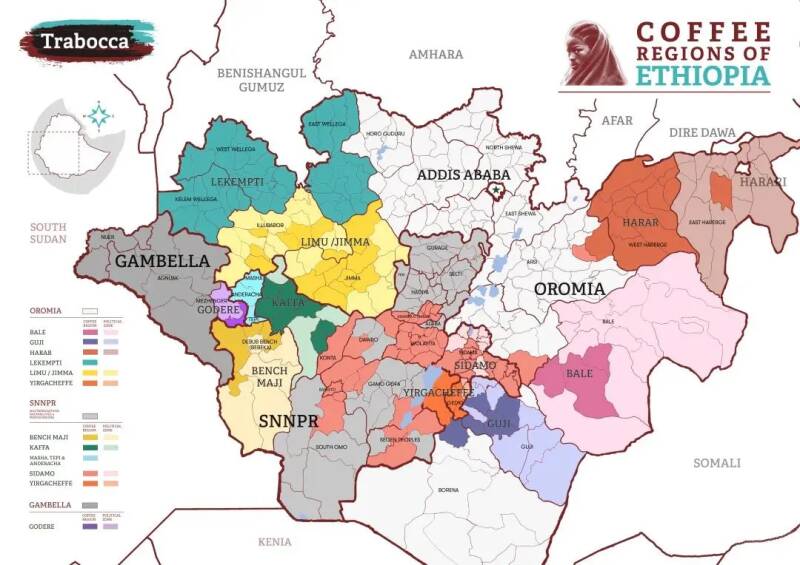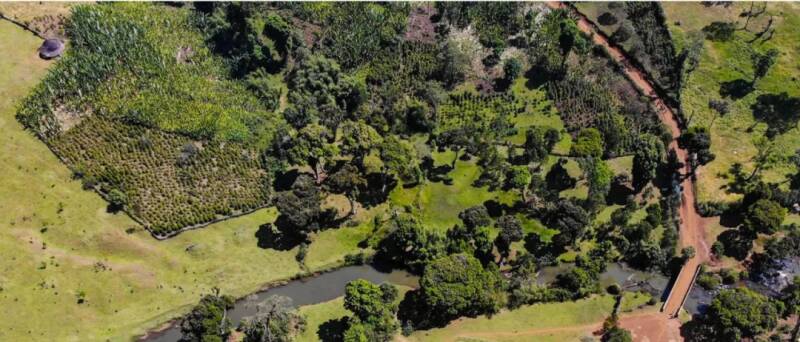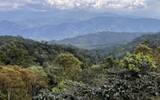Ethiopia| Introduction to Sidamo coffee producing areas such as Mudamo and Hamau Coffee
African coffee is well known in the global coffee market, in which the African country Ethiopia is recognized as the birthplace of coffee, and Ethiopia is the largest Arabica coffee producer in Africa, with a long history of coffee.
Ethiopia, located in northeast Africa, is a landlocked country with a land area of 1.1036 million square kilometers. In Ethiopia, there are mainly mountain plateaus, most of which belong to the Ethiopian plateau, accounting for 2 to 3 of the whole country. The East African Rift Valley runs through the whole territory, with an average elevation of nearly 3000 meters. Such a high altitude makes the annual average temperature in Ethiopia 16 ℃. The country is vast and rich in natural resources, rich in water resources, high-altitude mountains and more than 50 volcanoes, which make the country an ideal area for coffee cultivation.

Ethiopia has several coffee producing areas, namely, Sidamo, Harald, Kaffa, Limmu, Lekempti, Tepi, Bebeka and Bale. Now, with the development of boutique coffee, the demand for traceability of coffee beans has increased. Therefore, coffee beans in Ethiopia are now more accurate to sub-production areas or processing plants, such as Arbegona and Bensa in Sidamo production areas in recent years.
Sidamo: the original name of Sidamo was Sidama in history, but in order to strengthen the promotion of the uniqueness of coffee in the country, the Ethiopian government applied for a patent for the names of three producing areas in 2004, choosing the old name Sidama as the registration of Cedama Coffee. Until now, domestic consumers have always been used to calling the coffee here "Sidamo".

Sidamo straddles the fertile highlands south of Lake Awasa in the Great Rift Valley of East Africa, with an elevation of 1400-2200m and an annual rainfall of 1200-2000 mm. High altitude, sufficient Rain Water, pleasant climate and rich geological nutrients provide an ideal environment for growing coffee. And Sidamo has many well-known sub-producing areas, and coffee beans are planted in different soil and microclimate sub-producing areas, which makes the coffee flavor in Sidamo producing areas have different differences and characteristics.
Abbegona (Arbegona)-such as Rumudamo
Abbegona is a small town in the north-central part of Sidamo, adjacent to another sub-region, Bensa, where relatively well-known companies such as Mudamo Coffee Industry Trading Co., Ltd. (RumuDamo Coffee Industry Trade PLC) are located in recent years.
It is understood that the company was founded by seven shareholders in 2015, owns 1000 hectares of land to grow coffee beans and cooperates with more than 300 coffee growers. Focusing on the improvement of processing technology and equipment, the company bought a wet mill in 2018 to deal with washed coffee beans.
For example, the company became famous in 2020, when Ethiopia held the COE Cup for the first time. For example, the company took part in the competition and won the runner-up, the second runner-up and the eighth place. At present, the company mainly grows digital varieties 74110 and Ethiopian native species opened by the Jimma Agricultural Research Center (JARC).
Bansa (Bensa)-Hamasha (Hamasho)
Bensa is also located in a town in north-central Sidamo, and the recent fires of Alo coffee beans and Hama Matthew Hamasho coffee beans in Arlo Village in Bansha area have been put on shelves by a number of coffee roasters at home and abroad.
Hamasho is a processing plant located in the town of Banza. "Hama" means snake in Sidamo, symbolizing strength and spirit. It is one of 16 processing plants owned by Daye Bensa, a well-known local coffee trader, which was co-founded by Assefa and Mulugeta Dukamo in 1996 and currently works with 71 washing stations, 2500 farmers, 4 coffee villages and 11 drying stations.
Daye Bensa, headquartered in the capital Addis Ababa, has 16 washing treatment plants and 4 processing plants. Hamasho is one of them. The treatment plant is also famous. It participated in the Outstanding Cup COE competition in 2021 and 2022, winning the eighth place in 2021 and the second place in 2022. In addition, the company has two coffee farms and will work with other small farmers to study coffee cultivation, maintain equipment, provide training and technical support.
At present, two kinds of coffee beans such as Rumudamo and Hamasho have been purchased in Qianjie, and cup tests have been carried out. For example, Rumudamo coffee beans will have lime-like aroma when smelling, citrus acid and apple juice flavor in the mouth, fructose-like sweetness and slight tea feeling.
On the other hand, Hamasho coffee beans have a slight floral and citrus aroma, with berry, grape juice, black plum and Brin flavors in the mouth.
Important Notice :
前街咖啡 FrontStreet Coffee has moved to new addredd:
FrontStreet Coffee Address: 315,Donghua East Road,GuangZhou
Tel:020 38364473
- Prev

Peruvian coffee production increased by 7%! Coffee and other agricultural products are expected to increase exports to China
Recently, the U.S. Department of Agriculture released the status of the coffee industry in Peru, a South American country. According to the report, in the previous year, coffee production in Peru decreased due to the impact of the El Niño phenomenon. But at present, Peru has basically escaped the impact of El Niño and has an increasing trend in coffee production and exports. It is expected to be in 20.
- Next

Jay Chou suspected of opening a coffee shop in Beijing and attracting fans to check in!!
▲ Click to pay attention| Daily Boutique Coffee Culture Magazine Coffee Workshop "My love for you was written in the BC, buried deep in the Mesopotamia Plain ~" How many people fell into Jay Chou's trap because of this song, and it has been out of control since then? It will be a whole youth when you leave, and how many people are still repeating Jay Chou's song today
Related
- Can artificial hand brewing replace the barista's real hand brewing coffee? What is the difference between making coffee with fake hands and making coffee with real hands?
- Can't sell it?! Coca-Cola gives up selling Costa!
- The brewing parameters of the world's top rose summer coffee, ratio, water temperature, grinding and sharing! Graphic teaching on Emerald Manor Rose Summer Brewing Method!
- Jasmine milk tea, a new cup of ice?! Netizen: Why don't you just sell ice cubes
- Is it necessary to buy a cloth powder for an espresso machine? Why should we evenly distribute the powder when extracting espresso?
- What is the grinding ratio, water temperature and powder amount needed to make Combo in Mocha pot coffee? Mocha pot is suitable for making coffee deep and light baked beans??
- Caught off guard! Starbucks '15-year-old store quietly closes!
- Naixue Drink drank a stone and claimed a claim was retaliated by the merchant?!
- What is the difference between a cake filter cup and a V60 conical filter cup? What are the advantages and disadvantages of the flat-bottomed filter cup brewing solution?
- What is the difference between fine coffee powder and medium coarse coffee powder? Do I need to sift out the fine coffee powder for making coffee by hand?

